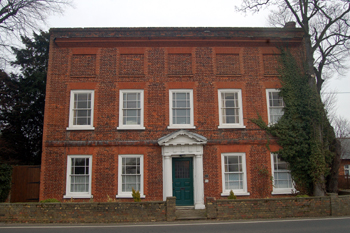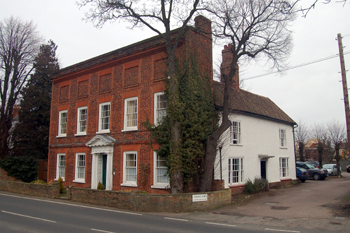College Farmhouse - 59 High Street Great Barford

59 High Street from the front March 2010
59 High Street, College Farm, was listed by the former Department of Environment in July 1964 as Grade II, of special interest. The department dated the property to the 17th and 18th centuries. The 17th century south-east wing was built of colour washed roughcast over a timber frame, and had Ann old clay tiled roof with a zigzag pattern. It had a three bay plan and two storeys. The 18th century block is the one facing the road and is built in red brick with an old clay tiled roof. It has a five bay façade and three storeys. In 1905 the farm was occupied by Benjamin Jefferies. A photograph of him appears in the Great Barford Women's Institute scrapbook.
![Benjamin Jefferies of College Farm 1905 [X535/5]](/CommunityHistories/GreatBarford/GtBarfordImages/Benjamin Jefferies of College Farm 1905 [X535-5].jpg)
Benjamin Jefferies of College Farm 1905 [X535/5]
In 1913 College Farm was owned by F. W. Davison and tenanted by M. Brunt. A letter from Brunt survives in the archive of solicitor John Thomas Green of Woburn [HN10/372/Howard4], it reads: “You ask of my experience in managing land. I have been in the market gardening all may life, I have managed this farm for Mr F.W. Davison nearly 6 years I shall be leaving on my own hands, it is not because I have to leave Mr Davison only I thought I would like to get somewhere on my own”.
The Rating and Valuation Act 1925 specified that every building and piece of land in the country was to be assessed to determine its rateable value. Most of Bedfordshire was valued in 1927 and the valuer visiting College Farm [DV1/H13/54] found it still owned by F. W. Davison and occupied, like Green End Farm and Creakers Farm, by Davison himself and Stanley William Logsden at a nominal rent. The farm was a large one at 670 acres and may have been named after Higham Ferrers College, a collegiate church, similar to that in Northill, founded by Archbishop Henry Chicheley in 1428 basing some of its income on Veseys Manor in Great Barford.
The house comprised a dining room, two drawing rooms, a kitchen, scullery, dairy and parlour with five bedrooms and a bathroom and w. c. using pumped water above. The valuer commented: “Nice House but close to Road”. A garage and a brick and tiled office measuring 19 feet by 12 feet stood outside.
The homestead comprised: a two stall nag stable; a nine stall stable; a chaff house; three pigsties used as stores; two piggeries; a two bay barn with a dirt floor; a seven bay return hovel; a four bay covered yard; a lean-to implement shed; a store house; a second four bay covered yard; a two bay hovel; a cow house used for stores; a barn used as a chaff house and mill; a trap house with an onion loft beyond; an eleven bay return hovel; a loose box; a seven stall stable; a store (“locked”); a granary store (“locked”); a store house with a copper; two potato chitting glass houses and a four bay cart shed.
In July 1932 a severe fire broke out at College Farm. The Bedford Volunteer Fire Brigade’s scrapbook [AD1082/4] contains a newspaper account, dates 31st July, which reads as follows: “Damage amounting to several thousand pounds was done by an outbreak which occurred on Sunday afternoon at College Farm, Great Barford, owned by Messrs Davison and Logsden. The driver of a passing motor-bus saw smoke coming from the thatch of some outhouses that stood by the side of the public footpath leading to the church. He stopped the bus, and with the help of the conductor attempted to deal with the fire by means of the chemical extinguisher from the bus, but, finding this of no avail, they gave the alarm at once”.
“The Bedford Brigade received the call at 4.30 and turned out under Chief Officer F. Corby with the motor tender and trailer-pump and within fifteen minutes they were running out lengths of hose, of which over 2,000 feet had to be used to bring water from the river. When the Bedford Brigade arrived (two minutes after the Sandy Brigade) they found that P. C. Piggott had a number of helpers and formed a chain of buckets and appeared to have the fire under control, but a sudden breeze sprang up and the flames began to spread with alarming rapidity. Soon the whole range of farm buildings – thatched barns, sheds, workshops and stables – as well as several straw stacks were a mass of flames, and the smoke from the fire was visible for miles around. The Bedford firemen concentrated their efforts upon saving a huge storage barn made entirely of wood and thatch. It is reputed to be five hundred years old and is a fine piece of old-time workmanship. By drenching it with water the Bedford firemen were able to preserve it undamaged, and several modern buildings close by were similarly protected by the Sandy Brigade, under Chief Officer Tingey”.
“No livestock was involved, all the animals being out in the fields at the time, but some valuable agricultural machinery, including electrically operated plant, was destroyed”.
“Pumping from the river was kept up continuously until after midnight. Sandy Brigade left at 12.30 a. m., leaving the Bedford men to douse the smouldering remains and to deal with a series of smaller outbreaks that occurred during the night. They returned at mid-day on Monday”.
The barn mentioned in the newspaper report was formerly listed by the Department of Environment as Grade III, but this grade no longer exists and so the barn is no longer listed. Bedfordshire's Historic Environment Record [HER] is now on-line as part of the Heritage Gateway website. The entry for the barn [HER 23190] notes that the structure is 16th or 17th century. It is a large timber framed barn with plaster infilling and still has its thatched roof. Another fire broke out in 1989 as the result of stubble burning [PCGreatBarford10/4].
The following year an application for planning permission [RDBP2/1083] was put in for an extension and new offices to be built at the farm. In 1978 an application was made [PCGreatBarford18/36] to extract sand and gravel from land at the farm and to construct a reservoir. The sign outside College Farm notes that it is still [2010] owned by Davison & Company Limited.
 College Farm - 59 High Street March 2010
College Farm - 59 High Street March 2010